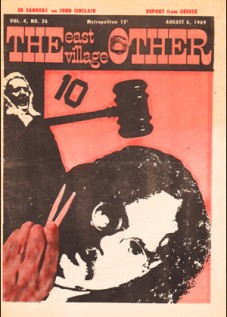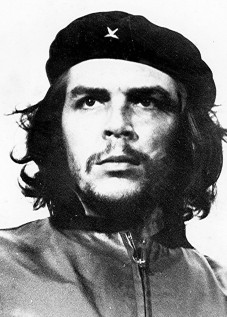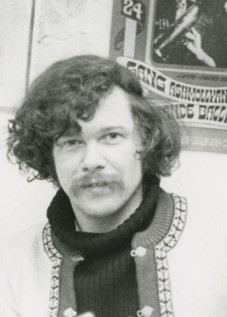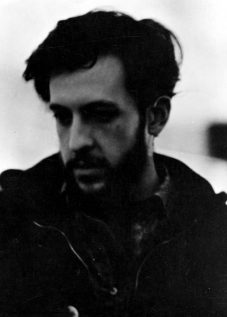Ed Sanders on Yeah, Exorcism & Electric Stencil Cutting
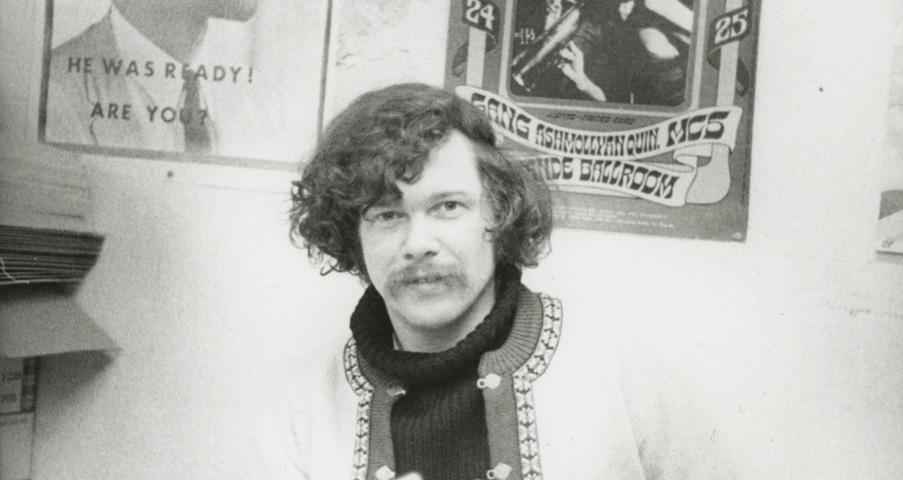
Ed Sanders visiting the Artist Workshop, photo by Leni Sinclair,1968
“Poetry is the most intimate path, in my opinion, toward confronting Ultimate Truth for Humans; Music comes close behind Poetry in this regard. Both will help us overcome The Creeping Meatball of Ennui, Self-Doubt, Defeat and Negativtism.” -Ed Sanders
Poet, activist, publisher, humorist, musician, founder of the Youth International Party, founder of the The Fugs, author of The Family (a bestseller on the Manson cult, still in print after four decades) producer of fugitive poem pamphlets and prose beginning in 1962 with Poem From Jail, written on toilet paper and smuggled out of jail, master of mimeography Egyptian stenciling, gatekeeper of a secret on the location lower East side, proprietor and headquarters for notorious Peace Eye bookstore, author of Investigative Poetry–a manifesto of large import, poetic historian, novelist, Woodstock archivist. Ed Sanders is a cosmic comet projectile of the 1960s and a large influence on John Sinclair and the Artists Workshop.
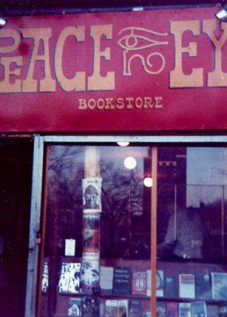 The Peace Eye was an infamous hangout; hosting book parties and art happenings. Sander’s describes the bookstore and his early association with Fug-mate Tuli Kupferberg: “I rented a former Kosher meat store on East 10th Street in late-1964, with groovy tile walls and chicken-singeing equipment which I transformed into a vegetarian literary zone called the Peace Eye Bookstore. I left the words “Strictly Kosher” on the front window. Next door above the Lifschutz wholesale egg market lived Tuli Kupferberg, a beat hero who was featured in anthologies such as The Beat Scene, and who published several fine magazines, Birth and Yeah, which he sold on the streets of the East and West Village.”
The Peace Eye was an infamous hangout; hosting book parties and art happenings. Sander’s describes the bookstore and his early association with Fug-mate Tuli Kupferberg: “I rented a former Kosher meat store on East 10th Street in late-1964, with groovy tile walls and chicken-singeing equipment which I transformed into a vegetarian literary zone called the Peace Eye Bookstore. I left the words “Strictly Kosher” on the front window. Next door above the Lifschutz wholesale egg market lived Tuli Kupferberg, a beat hero who was featured in anthologies such as The Beat Scene, and who published several fine magazines, Birth and Yeah, which he sold on the streets of the East and West Village.”
YEAH, EXCORISM & ELECTRIC STENCIL CUTTING: A SHORT CONVERSATION WITH ED SANDERS 9/07/2004
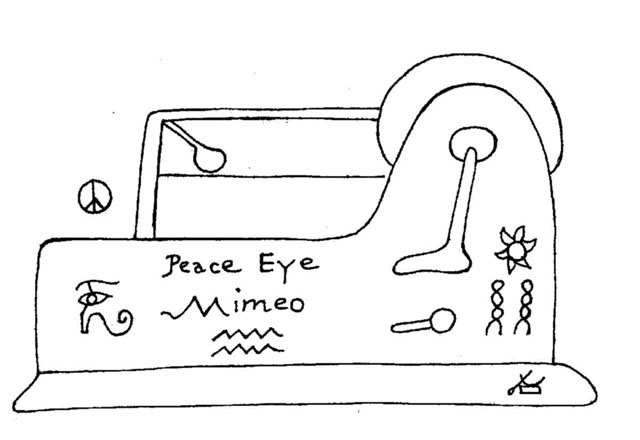 [ on 9|07|04 Ed Sanders spoke with Cary Loren about the Mimeograph Revolution, meeting Sinclair, the Artist’s Workshop, the FUGS, and getting tear-gassed in Chicago]
[ on 9|07|04 Ed Sanders spoke with Cary Loren about the Mimeograph Revolution, meeting Sinclair, the Artist’s Workshop, the FUGS, and getting tear-gassed in Chicago]
CL: when was the first meeting between you and John ?
ES: He started mailing me the Artists’ Workshop Newsletters around ’65 and I didn’t always read these things, but what I liked about it was, it was condensed… it wasn’t blather, it was REAL. He talked about McCoy Tyner or Amiri Baraka and about POETRY and I somehow learned he was working on his masters degree about William S. Burroughs and Burroughs was a friend of mine, we used to hang out a lot and I published some Burroughs pieces, and so I heard about a guy in Detroit that was writing his master thesis on Burroughs, and so we got along, we spoke the same language, and both of us read at the Berkley Poetry Conference in the summer of 1965.-those were groovy times. But physically our meeting must’ve been around ’66 — John brought us (THE FUGS) in to play at Wayne State University, then we’d go hang out at the Workshop… We always had a great time in Detroit.. later we’d play the Grande Ballroom, and bands like Sly & the Family Stone and the Psychedelic Stooges would open for us. We always did well in Detroit… it was a HOT TOWN for the FUGS… I remember one time, John and I even wrote a poem together driving to the airport in May of ’67… and just as we were getting to the airport we saw our plane taking off…
CL: do you still have that poem?
ES: I do.
CL: any chance of publishing it?
ES: I’m not sure I’d wanna publish it… it is A WORK OF ART… but you gotta know when to print ’em, and when to squint ’em.
CL: squint ’em? — haven’t heard that before.
ES: I just made it up. .. but anyway, we did hang out a lot, first at the Artist’s Workshop and later when they moved to Ann Arbor… In Chicago I made arrangements with the Chicago parks department to get power for the MC5 concert (at the ’68 Democratic National Convention) It was the only musical event that happened there. The MC5 drove in, set up, and I took the plug and plugged ’em in to the sound system at the kiosk in the park… and they played with an American flag on their big amps, REAL AMERICANA …showing the best qualities of an often good nation… and then they did their gig and were on the road headed out of town, which was lucky for them, ’cause that meant they didn’t get tear-gassed or WHOMPED.
On The Peace Eye Bookstore & Fuck You/ A magazine of the arts
CL: how did you come up with the name Fuck You Press?
ES: well, it was a catchy title; it got right to the point.
CL: what was the comic show like?
ES: that was at PEACE EYE, when we moved to the Avenue A location, early ’68… we moved into the East Village Other offices… that was one of the first ever underground comix exhibitions, it occurred in November, ’68. We had Art Speigelman, Robert Crumb, Kim Deitch, Bill Beckman and Spain Rodriguez… Spain did the TRASHMAN series, he was the only Marxist comic book artist I knew… a brilliant artist, still around I think,… he did the sign for PEACE EYE… and he also did the sign for the FREE STORE around the corner. We always had artshows going on… in one we showed works by Gregory Corso… we did a book party for Abbie Hoffman’s Revolution for the Hell of It.
CL: and the mimeograph work was done there?
ES: I had a FREE mimeograph print center in the bookstore – where anybody could put out anything-it was a community free print center, and we printed thousands of flyers and poetry booklets… we’d print anything for anybody. I had the only electric stencil cutter back then…
CL: Was that your drawing on the cover of Roosevelt After the Inauguration ? (William S. Burroughs, Fuck You Press)
ES: well, Ginsberg drew that, I supplied him with a primitive light board and some cutting instruments. It was an ARTFORM cutting stencils. You had to have a whole bunch of tools to do it well-which I still have. In fact, I still have my mimeograph machine in my garage… ’cause if Bush.. if they ever open up CAMP ASHCROFT, I can start printing leaflets almost immediately – I don’t need electricity, I got ink. I got stencils. And I got my 1966 GESTETNER mimeograph machine… what did Kerry say, “I will be reporting for duty” – for mimeograph duty if CAMP ASHCROFT opens.
CL: I heard they don’t make parts for mimeograph machines anymore.
ES: well, they do what they do for old Dodges. You need a loner, they’re out there, there are still people today who mimeograph as an artform. In my youth, I was sort of the WILLIAM BLAKE of my era, ’cause I could draw on the stencils, pretty well actually. So I trained myself, and got these real small engraving tools which I used on the stencil film.
CL: those lost technologies are kind of fascinating.
ES: yeah, ya see, they didn’t keep William Blake’s heavy stone press he had, they just got rid of it. They should’ve kept it and his engraving tools – there just isn’t anything around. They all got dispersed and sold.
CL: that’s great you kept everything.
ES: whatever University winds up with my archives has to have my mimeograph machine, that’s gonna be part of the deal.
on midwest presses & the best minds of a generation
CL: I was thinking how many of the best ideas in the sixties came not through individuals, but through small groups and scenes that brought people together-just like earlier avant-gardes. Were you in touch with any other Mid-western presses like the one out of the Asphodel bookstore?
ES: d.a.levy bought a letter press in ’63 and through ’66, until his suicide he printed really brilliant books-he mimeographed and letter pressed. He worked out of the ASPHODEL Bookstore (after a William Carlos Williams poem). His press was called THE RENEGADE PRESS and it printed hundreds of small poetry booklets. He printed one of my first books in ’64-a letter press book with his own artwork, he also printed an early underground newspaper called THE BUDDHIST THIRD CLASS JUNK MAIL ORACLE.
CL: that’s great.
ES: it was quite a beautiful collaged tabloid, that ran ads. He also printed THE MARIJUANA QUARTERLY. He was in trouble all the time in Cleveland, with the law. He came once to New York, to my bookstore-D.A. Levy was a really great, underrated poet, but to get to your point – it comes out of the first line of Ginsberg’s poem HOWL:
“I saw the best minds of my generation…”
– everywhere people tried to find the best minds of their generation-so that in Detroit, John hooked up with Charles Moore, Robin Eichele and George Tysh, and later there was the Cass Corridor scene and a confluence of music and writing and poetry and publishing and leftist politics. And the mimeograph revolution was a great statement from the left and John and I and d.a. levy and others were brothers and sisters under those banners, so it came about during an era of a lot of war money, the Vietnam war, so the livin’ was cheap, art was affordable, it was very affordable to put out these things.
CL: do you recall any other mimeograph presses?
ES: In New York City there were a lot of mimeograph presses, ANGEL HAIR, and YOWEL, there was THEO, and TELEPHONE BOOKS-a whole group of mimeograph presses. At poetry readings in the Lower East Side, there was a guy who came around and published a magazine right on the spot, he had his equipment right there and wrote down the stuff and got it printed-there was the instant quality-the instant gratification to be able to instantly put together a magazine or a broadside. In San Francisco there was BEATITUDE and a bunch of others all over. I don’t have the specific memories of other presses but there are University libraries that specifically collect this stuff, the Labadie Library at University of Michigan is one of them, also Brown University and the University of Texas. but what quickly came about beginning in 1964 and really 1965 was the underground press movement, which was all over America. There were these web presses that could very cheaply print newsprint-like The NATION, tabloid style, you could print a 1000 copies of an 8 or 16 page newspaper in half an hour.
on the exorcism of the Pentagon
CL: I really love the ads done for the PEACE EYE. Did you do those?
ES: It was an actual bookstore, that did very well actually, so I had a staff, a lot of the ads were done by managers and people working there. I was on the road a lot with THE FUGS and was doing many other things, as in community activism, working on demonstrations and the EXCORCISM OF THE PENTAGON in October ’67.
CL: was that the event where people circled the Pentagon and put daisies in the rifles?
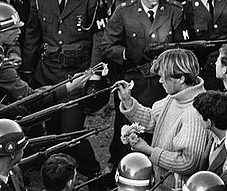
The Flower Power Pulitzer photograph by Bernie Boston, taken during “March on The Pentagon”, 21 October 1967.
ES: Tuli and I bought the daises.. THE FUGS just played the Ambassador Theater in Washington, and we were flush with cash, so we bought a whole bunch of daisies..
They were our flowers… people, including myself, stuck them into the barrels. Originally, we made arrangements for a small plane to fly over the Pentagon (!) and drop the daisies, but the plane was seized at the airport.
CL: you were going to drop the flowers over the Pentagon?
ES: not me personally, but we made arrangements. We also had a cow that was painted in psychedelic paint with a lot of occult symbols.. like the goddess HATHOR, the Egyptian goddess of education and schools. We were gonna bring it in, but the cow was stopped… and our plane was stopped.
CL: there was a famous photograph taken there that won the photographer the Pulitzer prize. It appeared in Life Magazine-it shows a long haired kid stuffing a daisy into a rifle pointed at him. It turns out the kid in the picture was HIBISCUS, a student of Jack Smith and Irving Rosenthal. He was on his way to San Francisco with Irving. They formed a commune together and Hibiscus later founded the performance group THE COCKETTES.
[Related poem: Ed Sander’s Exorcism of the White House 3/13/17]
ES: It was a wild time, what can I say?
CL: have you decided where your archives are going?
ES: No. I use the stuff. I’m writing a 9 volume history of the United States and I’m right in the middle of it. Three volumes have been published and I’m busy. I just finished all four volumes of TALES OF BEATNIK GLORY. I used a lot of my files for that and that should come out by winter of next year.
CL: Will Black Sparrow continue to publish your AMERICAN HISTORY IN VERSE?
ES: Yes, volume three just came out and four will be out in about a year. Yeah, so I got something to do. I have my files and I visit them, and I use them, I peruse them, I touch them, look at them…
CL: What was Tuli Kupferberg printing in the sixties?
ES: He published BIRTH MAGAZINE and he published YEAH In 1960, ’61, ’62, ’63, ’64, he self-published 1001 WAYS TO AVOID THE DRAFT, he published a lot of small books and magazines, and would sell them in Greenwich Village outside theaters.
CL: Is that how you met Tuli?
ES: yeah, I met him outside the Charles Theater, after a Ron Rice movie, not QUEEN OF SHEBA, the one before, THE FLOWER THIEF.
CL: what’s that noise in the background, it sounds like a parakeet.
ES: That’s my Cockateel.
CL: well thanks, you’ve been really helpful. I’m looking forward to meeting you at the Workshop events.
ES: I’m happy to come out and salute John’s leadership in artistry in November. It’s funny, I’m giving a talk on Yiddish speaking socialists of the lower east side and then getting on a plane for Detroit. I’m gonna bring some stencils and correcting fluid.
More background on Ed Sanders at Thirsting For Peace: An Interview With Ed Sanders by Kevin Ring
‘Fug You’: The Wild Life Of Ed Sanders at; NPR
Tags: Ed Sanders, Interviews, Mimeogarph, The Fugs, Tuli Kupferberg



